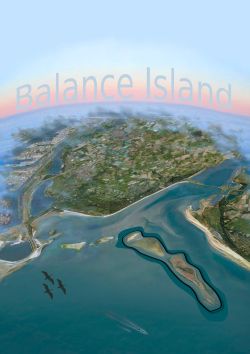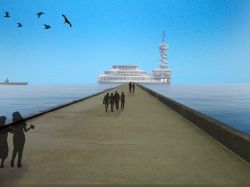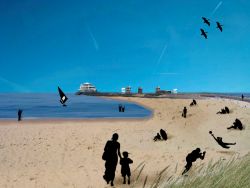Balance Island
Balance Island reduces salt intrusion in the Haringvliet by creating a smooth transition from salt to fresh water while preserving the unique dynamic character of the delta
Sander van Rooij, Bart van Bueren, Emil Kuijs
Balance Island’s primary function is to decrease the salt intrusion in the Haringvliet. This is achieved by creating a gradual transition from salt to fresh water, while conserving the dynamic nature of a living delta. By reducing the salt-intrusion, it is expected that the 'Kierbesluit' can be operated more effectively. The 'Kierbesluit' is a measure to stimulate fish migration by frequently opening the sluices of the Haringvlietdam. A lower salt-intrusion allows a more frequent opening of the sluices. This stimulates the migration of fish and retains a minimal salinity near the location Middelharnis, which is recognized as 'zero effect' line.
The Haringvliet is a show case of this innovative Dutch Delta Technology for many other estuaries around the world. With the forecast of sea level rise and on-going salinity problems, Balance Island offers a sustainable, simple and easy to maintain solution. Download pdf file.
|
|
|
Follow up
The implementation of Balance Island (an artificial island in front of one of the branches of the Dutch Delta) has as primary goal the reduction of salt water intrusion in the Haringvliet by creating a gradual transition from salt to fresh water while maintaining the unique dynamic nature of the delta. The jury of the Young Professional Award of the competition suggested to perform more detailed modelling studies on the real impact of Balance Island on the reduction of the salt water intrusion.
In the follow up study it has been checked on concept level whether a reduction in the salt content can be reduced through the construction of the island and what factors influence that salt content. Through various simulations with Delft3D a first insight is obtained into the effects of Balance Island on the salt intrusion in estuaries.
The model calculations show that when the Balance Island is constructed in the mouth of the Haringvliet a reduction of the salt content in the Haringvliet can be expected. Various model runs in the show that this reduction can be up to about 30%. It turns out that it is important how the island is positioned in the mouth of the estuary in relation to the incoming tide, how big it is and what form it has. It is expected that the creation of artificial islands in the mouth of delta river branches can also be applied in other deltas worldwide to achieve reduction of salt water intrusion.
Read final report (in Dutch, pdf)


